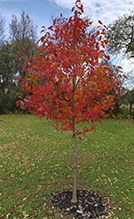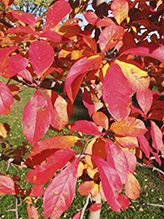black tupelo
(Nyssa sylvatica)
Conservation • Wetland • Description • Habitat • Ecology • Use • Distribution • Taxonomy
Description |
||
Black tupelo is a slow growing, very long lived, deciduous tree rising on a single trunk from a large, deep taproot. In the northern parts of its range mature trees are usually 16′ to 66′ tall and and 20″ to 36″ in diameter at breast height. In the south, they are typically up to 98′ tall and 39″ in diameter. In favorable conditions, large individuals can reach 120′ in height and 48 ″ in diameter. It usually occurs in the understory in an intermediate crown position. It grows slowly when under a canopy, faster when the canopy is removed. It is very long lived, with some individuals over 650 years in age. The trunk is straight. It is sometimes slightly swollen at the base when growing in water but never has buttress roots at the base. It is distinct into the upper part of the crown. The crown is often pyramidal when young, becoming oblong and irregularly rounded, and often flattening out with age. The branches are held more or less at right angles to the trunk. The lower branches are usually crooked and often droop downward. The bark on young trees is dark gray to brownish-gray and is divided into vertical ridges. On mature trees the bark is thick and brown to gray, with ridges that are broken into oblong or irregular, hexagonal plates. Older bark is thick and deeply ridged, resembling alligator hide. The outer sections of bark are often broken off on one side of the tree due to exposure to freeze and thaw cycles. The twigs are moderately slender, reddish-brown to gray, and often covered with fine short hairs. There are also dwarf branches, 1″ to 2″ long, curved, spur shoots. The pith is white and solid but has numerous hard, greenish, cross bars (diaphragmed). The leaf scars have 3 conspicuous bundle scars . Terminal buds are egg-shaped, pointed, and about ¼″ long. They are covered with 5 yellowish-brown to dark reddish-brown scales. Lateral buds are similar but smaller and diverge widely from the twig. The leaves are deciduous, alternate, unlobed, and somewhat leathery in texture. On young short shoots they are in clusters and appear almost whorled. On the major branches they are often in clusters at the tip. They are on 3 ⁄16″ to ¾″ long leaf stalks (petioles). The petioles are moderately to densely covered, sometimes only on upper or lower side, with spreading, branched, sometimes tangled hairs. The leaf blades are variable in shape but usually widest above the middle, inversely egg-shaped to elliptic, 2¼″ to 4¾″ long, and 1⅜″to 2½″ wide. They are broadly angled or tapered at the base and usually short tapered to a short, sharp point at the tip. The tip is sometimes rounded or angled. The upper surface is somewhat shiny and hairless. The lower surface is pale green but is not covered with a waxy bloom (glaucous). It may be either hairless or moderately hairy, especially along the veins. The lateral veins straight or only slightly arched toward the tip. They do not reach the margin. The margins are wavy, untoothed, and sometimes hairy. Rarely, there will be 1 to 3 coarse, broadly triangular teeth above the middle. In autumn the leaves turn various shades of yellow, orange, red, and purple. Male and female flowers are borne on separate trees from May through June, after the leaves have unfurled but before they are fully grown, but there are usually a few to several flowers with both male and female parts (perfect flowers) on each branch. They appear in the leaf axils, especially on the short shoots. The male (staminate) flowers are in short, dense, unbranched clusters (racemes), or sometimes in umbrella-like, ¼″ to 1″ in diameter clusters (umbels). They are on greenish-white, hairy, ⅜″ to ¾″ long inflorescence stalks (peduncles). The female (pistillate) flowers are solitary or in clusters of mostly 2 to 5 on ¾″ to 2″ long peduncles. The flowers are tiny and are not showy. They have 5 sepals, 5 to 10 petals, 8 to 15 stamens, and 1 style. The sepals (calyx) are green, fused at the base into a short tube, then separated into 5 tiny, 1 ⁄64″ to 1 ⁄16″ long teeth or a low rim. The petals are green to greenish-yellow or greenish-white, 1 ⁄64″ to 1 ⁄16″ long, oblong, and usually rounded at the tip. The stamens have slender, ⅛″ to ¼″ long stalks (filaments). The style is stout and bent or bent backward toward the tip. The stigma is unlobed. The fruiting head (infructescence) is a cluster of 2 to 5 stone fruits (drupes). Each drupe is egg-shaped, 5 ⁄16″ to ½″ long, and glaucous. It is green at first, turning bluish-black with scattered, minute, white spots at maturity. The taste is bitter. The stone has 8 to 12 shallow ridges. The fruit ripens in September and October and drops to the ground from September through November. |
||
Height |
||
16′ to 82′ |
||
Record |
||
There is no record for non-native trees. |
||
Flower Color |
||
Green to greenish-yellow |
||
Similar Species |
||
Habitat |
||
Moist to moderately moist. Upland and floodplain woodlands, wetlands, edges of swamps and streams. Moderately shade tolerant. Well-drained soil. |
||
Ecology |
||
Flowering |
||
May through June |
||
Pests and Diseases |
||
Tupelo leafminer (Antispila nysaefoliella) |
||
Use |
||
|
||
Distribution |
||||
|
Sources |
|||
| 2/22/2023 | ||||
Nativity |
||||
Native to eastern and southeastern United States, including Wisconsin. Occasionally cultivated. |
||||
Occurrence |
||||
Not known to occur outside of cultivation in Minnesota |
||||
Taxonomy |
|||
| Kingdom | Plantae (Plants) | ||
| Subkingdom | Pteridobiotina | ||
| Phylum | Tracheophyta (Vascular Plants) | ||
| Class | Magnoliopsida (Dicots) | ||
Order |
Cornales (dogwoods, hydrangeas, and allies) | ||
Family |
Nyssaceae (tupelo) | ||
| Genus | Nyssa (tupelos) | ||
Until recently, the genus Nyssa was included in the dogwood family (Cornaceae) in the subfamily Nyssoideae. In 2016, with the publication of the APG IV system, it was placed in the family Nyssaceae. |
|||
Subordinate Taxa |
|||
|
|||
Synonyms |
|||
Nyssa sylvatica var. caroliniana Nyssa sylvatica var. dilatata Nyssa sylvatica var. sylvatica Nyssa sylvatica var. typica |
|||
Common Names |
|||
black gum black tupelo blackgum black-gum sour gum |
|||
Glossary
Calyx
The group of outer floral leaves (sepals) below the petals, occasionally forming a tube.
Drupe
A fleshy fruit with usually a single hard, stone-like core, like a cherry or peach; a stone fruit.
Filament
On plants: The thread-like stalk of a stamen which supports the anther. On Lepidoptera: One of a pair of long, thin, fleshy extensions extending from the thorax, and sometimes also from the abdomen, of a caterpillar.
Glaucous
Pale green or bluish gray due to a whitish, powdery or waxy film, as on a plum or a grape.
Peduncle
In angiosperms, the stalk of a single flower or a flower cluster; in club mosses, the stalk of a strobilus or a group of strobili.
Perfect
Referring to a flower that has both male and female reproductive organs.
Petiole
On plants: The stalk of a leaf blade or a compound leaf that attaches it to the stem. On ants and wasps: The constricted first one or two segments of the rear part of the body.
Pistillate
Referring to a flower that has a female reproductive organ (pistil) but does not have male reproductive organs (stamens).
Raceme
An unbranched, elongated inflorescence with stalked flowers. The flowers mature from the bottom up.
Sepal
An outer floral leaf, usually green but sometimes colored, at the base of a flower.
Staminate
Referring to a flower that has a male reproductive organs (stamens) but does not have a female reproductive organ (pistil).
Stigma
In plants, the portion of the female part of the flower that is receptive to pollen. In Lepidoptera, an area of specialized scent scales on the forewing of some skippers, hairstreaks, and moths. In Odonata, a thickened, dark or opaque cell near the tip of the wing on the leading edge.
Umbel
A flat-topped or convex, umbrella-shaped cluster of flowers or buds arising from more or less a single point.
Visitor Photos |
|||||
Share your photo of this plant. |
|||||
| This button not working for you? Simply email us at info@MinnesotaSeasons.com. Attach one or more photos and, if you like, a caption. |
|||||
Randy |
|||||
Black tupelo thriving and showing off Autumn color, Freeborn County, MN, October 2017 |
|||||
 |
 |
||||
Black tupelo foliage, Freeborn County, MN, September 2017 |
|||||
 |
|||||
MinnesotaSeasons.com Photos |
|||||
|
|||||

Visitor Videos |
|||
Share your video of this plant. |
|||
| This button not working for you? Simply email us at info@MinnesotaSeasons.com. Attach a video, a YouTube link, or a cloud storage link. |
|||
Other Videos |
|||
| Trees with Don Leopold - blackgum ESFTV |
|||
About
Published on Oct 21, 2011 |
|||
| #PhenologyFriday: Meet the Blackgum caseytrees |
|||
About
Published on Oct 23, 2015 Stephanie talks about the colorful Nyssa sylvatica in our latest #PhenologyFriday video. |
|||
| Black Gum (Nyssa sylvatica) Gregg Smith |
|||
About
Published on Feb 10, 2014 Black Gum tree (Nyssa sylvatica) One of Ontario's rarest native trees... Found scattered only in Essex, Kent, Norfolk counties and in the Niagara region... This one is growing just south of Thamesville, Ontario... This video is copywrited.... All rights reserved... |
|||
| How to ID Nyssa sylvatica Laura Deeter |
|||
About
Published on Nov 19, 2008 Short video showing the key identifying characteristics for Nyssa sylvatica |
|||
| Blackgum (Nyssa sylvatica) NativNurseries |
|||
About
Published on Sep 29, 2011 Dudley Phelps and Blake Hamilton of Mossy Oak Nativ Nurseries explain the wildlife bennifits of this often overlooked tree, the Blackgum. All types of wildlife enjoy the soft mast this tree produces, especially wild turkey and whitetail deer, watch the video and learn more! Please Subscribe to our Channel |
|||

Visitor Sightings |
|||||
Report a sighting of this plant. |
|||||
| This button not working for you? Simply email us at info@MinnesotaSeasons.com. Be sure to include a location. |
|||||
| Randy October 2017 |
Location: Freeborn County, MN Black tupelo thriving and showing off Autumn color |
 |
|||
| Randy September 2017 |
Location: Freeborn County, MN Black tupelo foliage |
 |
|||
MinnesotaSeasons.com Sightings |
|||||
|
|||||

Created: 10/3/2017
Last Updated:


